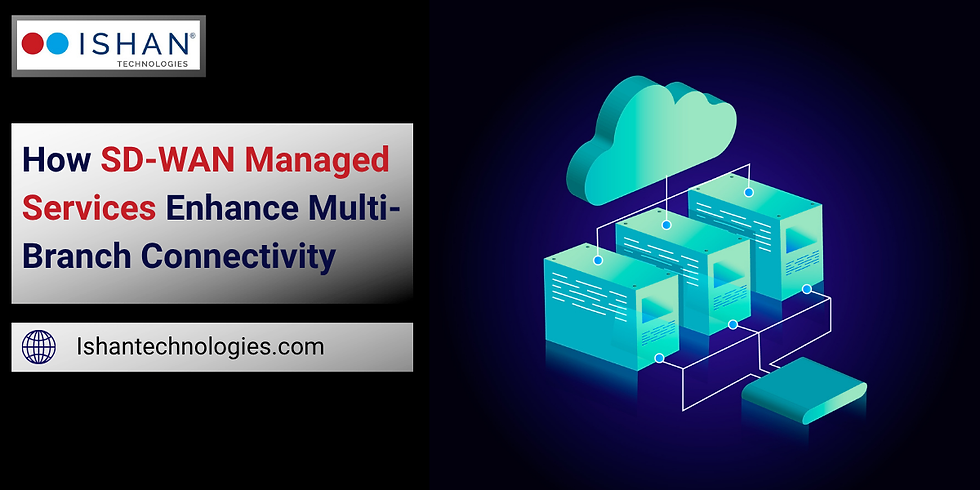How SD-WAN Managed Services Enhance Multi-Branch Connectivity
- ishasharm151
- Jul 16
- 4 min read
Designing seamless, secure, and scalable connectivity has always been a recurring problem for an organization with multiple branches or perhaps a few remote offices in this rapidly evolving digital landscape. Traditional WAN architecture cannot quite keep up with bandwidth increases, security threats, and above all, the cloud-first working environment of modern-day companies. Hence, SD-WAN managed services have become a modern-day approach to redefining the connection paradigm of distributed locations for organizations.
The article lays out how SD-WAN managed services bring about improvements in multi-branch connectivity, thereby benefiting performance, security, scalability, operational complexity, and costs.

What Are SD-WAN Managed Services?
The Software Defined Wide Area Networking (SD-WAN) infrastructure is basically a virtual WAN architecture where the software in question takes care of the configuration of network connectivity and network traffic flow across several transport services such as MPLS, broadband internet, and LTE. A fully operating SD-WAN solution would be supported and maintained by the service provider, meaning that companies can essentially decide whether to outsource deployment, monitoring, optimization, or maintenance.
Managed SD-WAN, technically, denotes the management of its deployment and solutions, but the more generic term, “Managed Services for SD-WAN,” refers to the actual operations of an SD-WAN network. These services merge the perks of software-defined networking with expert assistance, thus allowing enterprises to run a more agile, resilient, and secure network environment without actually managing it internally.
1. Centralized Control and Visibility Across Branches
The biggest advantage here in SD-WAN managed services is centralized orchestration. Through one dashboard, a business learns everything about network activity across multiple branches and controls it. This centralized management ensures that IT teams take pride in the fast roll-out of new applications, policies update, or troubleshooting-newly in any location, no matter how far away.
Once the network performance was made visible to an organization, it would have started thinking about ways to use bandwidth capacity optimally to minimize latency and maximize user experience from site to site.
2. Improved Network Reliability and Redundancy
For a business with locations scattered all over the country, consistent uptime goes a long way in ensuring a seamless operation of the business. Traditional WANs based on MPLS or leased lines get outages quite often, not to mention the costs involved in scaling up. SD-WAN-managed services solve this problem by letting branches simultaneously leverage multiple connections (MPLS, broadband, LTE, etc.). Having many paths means redundancy and load balancing are available.
When a link fails, SD-WAN instantly reroutes traffic to the path that is performing best without disrupting the user experience. The branch offices stay online while critical applications continue to work flawlessly.
3. Optimized Performance for Cloud and SaaS Applications
Today, businesses are increasingly finding their cloud platform and SaaS application dependence, be it Microsoft 365, Salesforce, or Google Workspace. Conventional WANs, during traffic flow, transmit it via a centralized data center, leading to an increase in latency and a decrease in performance.
Hence, direct Internet access is granted for each branch office with SD-WAN managed services so that access to cloud applications is secured and optimized. Intelligent traffic steering further prioritizes latency-sensitive applications so that applications such as VoIP or video conferencing continue to achieve increasing levels of productivity and enhance end-user experience.
4. Enhanced Security and Compliance
The increasing complexity of cyber threats creates a multi-branched network. SD-WAN managed services offer innate security features like end-to-end encryption, firewall, secure web gateways, and network traffic segmentation.
These services would often interface with next-gen security platforms to some extent for threat response detection, intrusion prevention systems, and zero-trust network access. MSPs help enable organizations to be compliant with various legislations such as GDPR, HIPAA, and PCI-DSS by enforcing security policies uniformly across all sites.
5. Scalability and Faster Deployment
Expanding a traditional WAN into new branch offices can take weeks and sometimes even months due to technical hardware considerations and configuration issues. SD-WAN, new sites can stand up in a matter of hours through zero-touch provisioning.
Once new stores open, it would then scale, particularly for retail chains, banks, and healthcare providers. It is a full setup managed by managed SD-WAN providers to allow IT to focus on strategy rather than infrastructure issues.
6. Cost Efficiency and Reduced Operational Overhead
Legacy WAN architectures are expensive since MPLS circuits impose high costs, and on-site presence of dedicated IT personnel is needed. With SD-WAN managed service, an enterprise can make use of cheap broadband and wireless connections without compromising enterprise-grade performance and security.
In addition, outsourcing network management concerns means less work delegated to the internal IT team, which brings about a reduction in its operational overhead. With uniform pricing schemes and consolidated billing, it is easier to manage IT budgets across multiple branches.
7. Proactive Monitoring and 24/7 Support
An important plus in favor of taking SD-WAN for managed services is proactive monitoring and 24-hour support. The managed service providers continuously monitor the health of the network and its performance so that if ever an issue arises, problems are addressed first, with minimal loss to business operations.
The business gains faster issue resolution through an experienced help desk, making sure that connectivity stays uninterrupted, and the downtime at branch offices is kept to a minimum.
Conclusion
Strong and adaptable networking grows to becomes very essential when an organization grows in size and embraces hybrid work models. Nowadays, SD-WAN managed services by Ishan Technologies present a forward-looking approach to scaling the connection and securing of many branch offices. On the contrary, there cannot be any more benefits to SD-WAN than centralized management, enhanced security paradigm, cost reduction, and better cloud performance, demanding a digital toll on the enterprise.
In association with a proven SD-WAN managed services provider, they obtain consistent and high-performing connectivity platforms via the backbone of innovation and growth, and something better in customer experience at each branch. Contact us now.



Comments